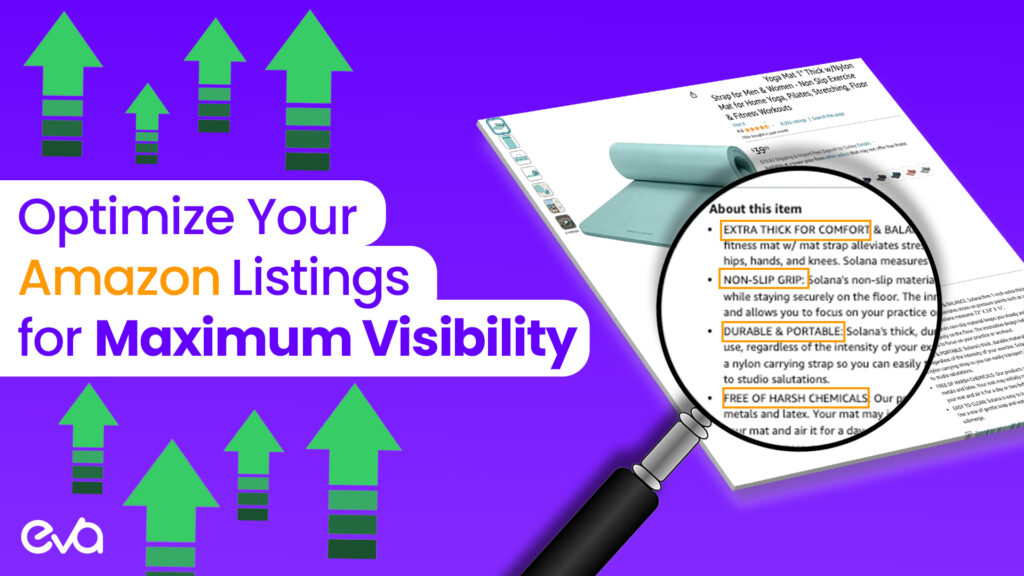Table of Contents
- Introduction
- Understanding Amazon’s Search Algorithm
- The Importance of Keyword Research and Optimization
- How to Incorporate Primary and Secondary Keywords
- Selecting High-Quality Images
- Writing Persuasive Product Descriptions
- Monitoring and Optimizing Performance
- Interpreting Data and Making Data-Driven Decisions
- How Eva Commerce Can Help
- Conclusion
- FAQs
Introduction
Are you struggling to get your products noticed on Amazon?
You’re not alone. With over 60% of product searches starting on this platform, it’s a highly competitive marketplace.
Simply listing your product isn’t enough to guarantee sales. To truly succeed, you need to optimize your listings for better visibility and higher conversion rates.
This guide will walk you through the essential steps for Amazon listing optimization, from crafting effective product titles to utilizing high-quality images and strategic keywords.
By the end, you’ll have the knowledge to make your products stand out and drive sales.
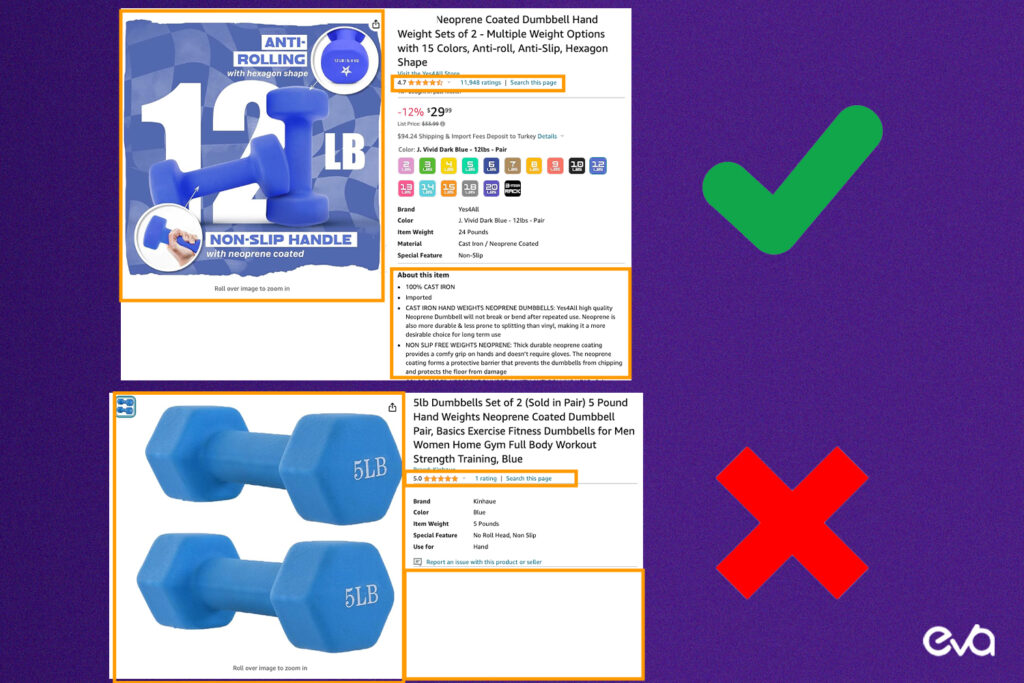
Understanding Amazon’s Search Algorithm
To optimize your Amazon listings effectively, it’s essential to understand how Amazon’s A9 algorithm works.
This algorithm ranks products based on relevance and performance, ensuring that the most relevant and best-performing products appear at the top of search results.
Key factors influencing your product ranking include:
- Product Title: A clear, concise, and keyword-rich title significantly impacts your ranking. It should accurately reflect what your product is and include primary keywords.
- Product Description and Bullet Points: Detailed descriptions and bullet points that include relevant keywords improve visibility. They should highlight the features and benefits of your product.
- Backend Keywords: These hidden keywords enhance searchability without cluttering the listing. They help your product appear in more search queries.
- Sales Performance: Products with higher sales tend to rank higher because Amazon prioritizes items that sell well.
- Customer Reviews and Ratings: Positive reviews and high ratings boost your product’s credibility and ranking. They act as social proof that your product is worth purchasing.
- Price Competitiveness: Competitive pricing makes your product more attractive to potential buyers and can improve its ranking compared to similar items.
The Importance of Keyword Research and Optimization
Keyword research is crucial for listing optimization. Using the right keywords ensures your product appears in relevant search results, increasing visibility and attracting potential buyers ready to make a purchase.
Tips for Conducting Effective Keyword Research
- Utilize AI Tools: Use platforms like Eva Commerce’s AI-powered platform to gain insights into customer search behavior and identify high-performing keywords.
- Competitor Analysis: Examine your competitors’ listings to identify their target keywords. Look for high-performing keywords that you can incorporate into your listings.
- Customer Reviews: Analyze customer reviews to discover commonly used keywords that describe your product or similar items. This can provide valuable insights into what customers are looking for.
By leveraging these tools and strategies, you can compile a comprehensive list of keywords to optimize your listings effectively.
Crafting Compelling Product Titles
Creating a compelling product title is essential for attracting customers on Amazon.
Your product title is the first thing shoppers see, and a well-crafted one can boost your search ranking and click-through rates.
Why a Well-Structured, Keyword-Rich Title Matters
A clear, concise, and keyword-rich title helps your product stand out in search results.
It gives potential customers a quick understanding of what your product is and what makes it special, increasing the chances of them clicking on your listing.
Effective Title Formats
To create an effective product title, use a structured format that includes:
- Brand Name: Start with your brand name to establish recognition.
- Key Feature(s): Highlight one or more key features that make your product unique.
- Material: If relevant, mention the material used in your product.
- Product Type: Clearly state the type of product you are offering.
Examples:
- “Eva Organic Cotton Baby Blanket – Soft, Breathable, Hypoallergenic – Ideal for Newborns”
- “Eva Stainless Steel Insulated Water Bottle – Leak-Proof, Double-Walled – Keeps Drinks Hot or Cold for 24 Hours”
How to Incorporate Primary and Secondary Keywords
Incorporate primary and secondary keywords naturally in your product title:
- Primary Keywords: Place these at the beginning. They should define the main product category or feature.
- Secondary Keywords: Use these for descriptive details like size, color, or extra features.
Avoid keyword stuffing, which can make your title look spammy. Focus on creating a natural flow that makes sense and includes important keywords.
Example: For a yoga mat: “Eva Non-Slip Yoga Mat – Extra Thick, Eco-Friendly Material – Perfect for All Types of Yoga”
By following these strategies, you can create product titles that rank well in search results and attract customer clicks.
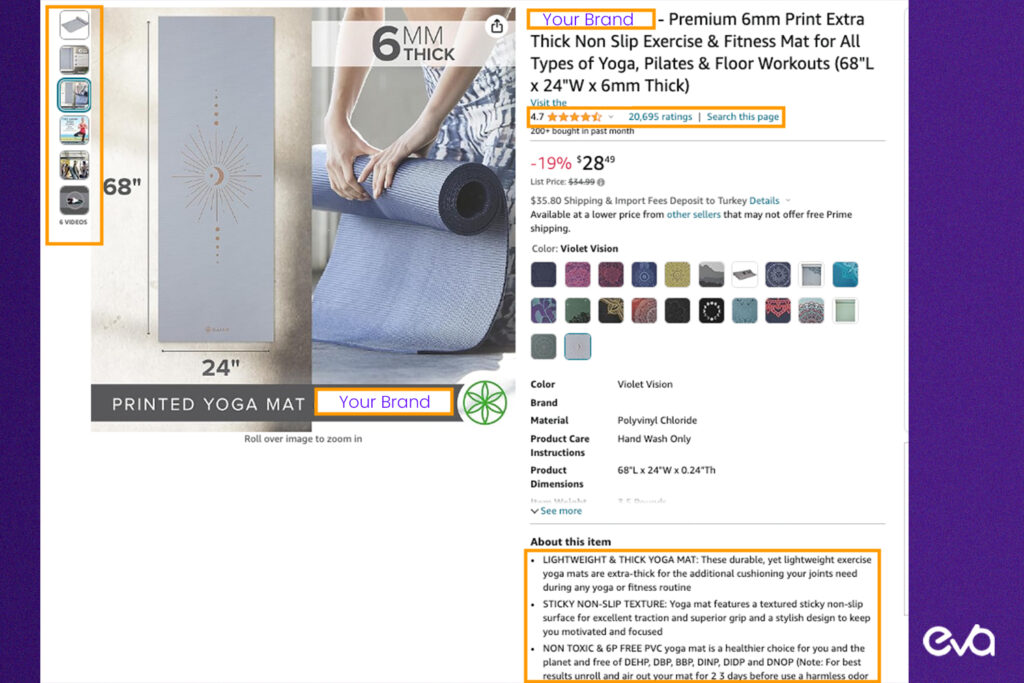
Selecting High-Quality Images
High-quality images are essential for attracting and engaging customers on Amazon. Visuals significantly impact customer decisions and conversion rates.
Why High-Quality Images Matter
Images are the first thing customers notice about your product. High-quality images can:
- Increase Customer Engagement: Visually appealing images capture attention and encourage further exploration of your listing.
- Boost Conversion Rates: Well-executed images help customers visualize the product and make informed purchasing decisions.
- Reduce Return Rates: Providing clear, accurate representations of your product helps manage customer expectations and minimizes the likelihood of returns.
Tips for Capturing High-Resolution Images
To capture high-resolution images that showcase key product features, follow these tips:
- Use a Good Camera: Invest in a quality camera to ensure your images are clear and sharp.
- Proper Lighting: Use natural or studio lighting to highlight the product’s details and colors.
- Multiple Angles: Show the product from different angles to give customers a complete view.
- Focus on Key Features: Highlight important features that set your product apart.
- Contextual Images: Include images showing the product in use to help customers visualize it in their lives.
Follow Amazon’s Image Guidelines
Following Amazon’s image guidelines is essential for ensuring your images meet the platform’s standards. Amazon requires:
- High-resolution images (at least 1000 pixels on the longest side)
- A white background for the main image
- No additional text, graphics, or inset images
Writing Persuasive Product Descriptions
Product descriptions are crucial for converting clicks into sales. A well-crafted description not only informs customers about your product but also persuades them to make a purchase.
Structuring Your Product Descriptions
To create a persuasive product description, use the following framework:
- Identify the Problem: Start by addressing a common problem or need that your product solves.
- Present the Solution: Explain how your product provides a solution to the problem.
- Highlight the Benefits: Focus on the key benefits and features that make your product stand out.
Example:
- Problem: “Tired of yoga mats that slip and slide during your practice?”
- Solution: “Our Eva Non-Slip Yoga Mat stays firmly in place, providing a stable surface for all types of yoga.”
- Benefits: “Extra thick for comfort, made from eco-friendly materials, and easy to clean.”
Incorporating Keywords for SEO
Incorporating keywords naturally into your product descriptions is essential for SEO. Here are some guidelines:
- Primary Keywords: Use these in the first sentence or two to grab attention.
- Secondary Keywords: Sprinkle these throughout the description to add detail and improve searchability.
- Natural Flow: Ensure that the keywords fit naturally within the text to maintain readability and persuasiveness.
Example: “Enhance your yoga practice with the Eva Non-Slip Yoga Mat. Designed to stay firmly in place, this extra-thick mat provides a comfortable and stable surface for all types of yoga. Made from eco-friendly materials, it’s easy to clean and perfect for both beginners and experienced yogis.”
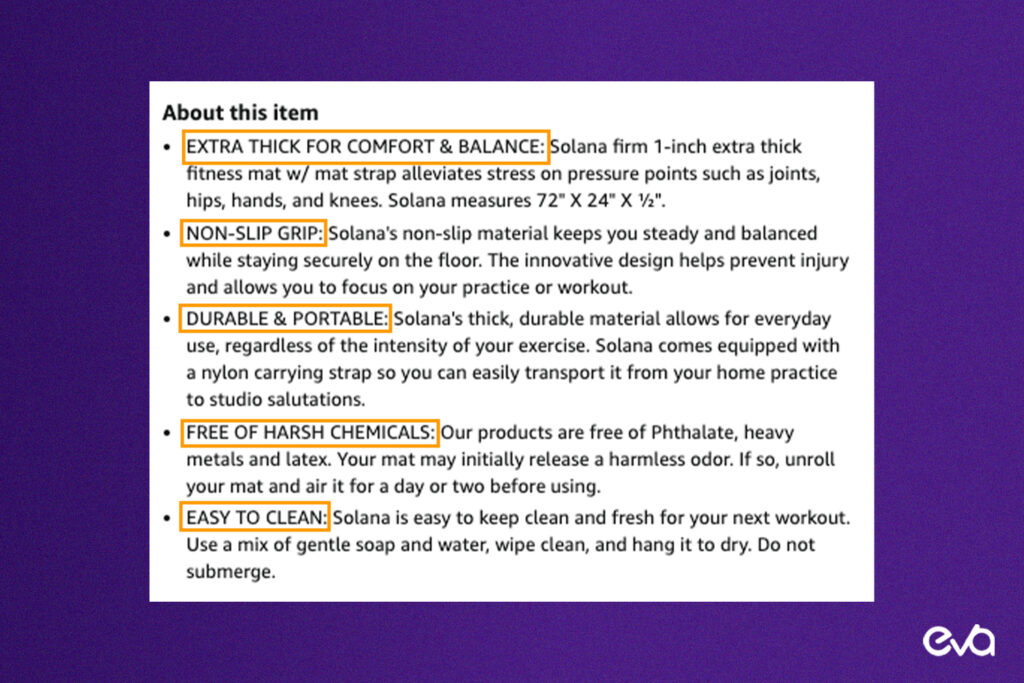
Utilizing Backend Keywords
Backend keywords are hidden search terms that you can add to your Amazon product listing. These keywords do not appear on the product page but help improve your product’s discoverability.
Benefits of Backend Keywords
- Enhanced Discoverability: Helps your product show up in more search queries.
- Increased Relevance: Allows you to target additional keywords without cluttering your product title or description.
- Better Search Rankings: Contributes to overall keyword optimization, boosting your product’s visibility.
Tips for Selecting Relevant and High-Traffic Backend Keywords
Selecting the right backend keywords is crucial for maximizing your product’s visibility. Here are some tips:
- Use AI Tools: Identify high-traffic keywords relevant to your product using platforms like Eva Commerce.
- Analyze Competitors: Look at the keywords your competitors are using to gain insights into which keywords drive traffic in your category.
- Focus on Long-Tail Keywords: These are longer, more specific phrases that customers might use. They often have less competition and can drive highly targeted traffic.
- Include Misspellings and Variations: Add common misspellings and variations of your primary keywords to capture more search queries.
Best Practices for Using Backend Keywords Effectively
To use backend keywords effectively, follow these best practices:
- Stay Within the Character Limit: Amazon allows up to 250 bytes for backend keywords. Make sure to use this space efficiently.
- Avoid Keyword Stuffing: Use relevant keywords that accurately describe your product. Avoid repetition and unnecessary keywords.
- Use Synonyms and Related Terms: Include synonyms and related terms to broaden your reach.
- No Need for Punctuation: Separate keywords with spaces rather than commas or other punctuation marks.
Example of effective backend keywords for a yoga mat:
- “non slip yoga mat”
- “eco-friendly exercise mat”
- “thick yoga mat for home”
- “yoga mat with carrying strap”
- “yoga mat for beginners”
By selecting the right backend keywords and following best practices, you can significantly improve your product’s discoverability and search rankings.
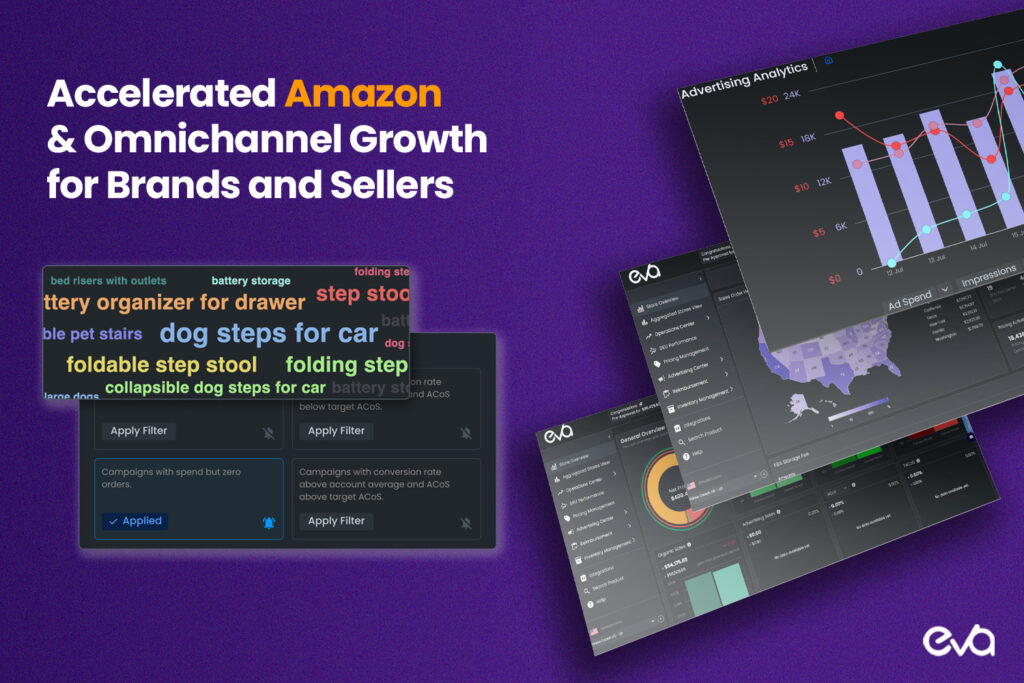
Monitoring and Optimizing Performance
To ensure your Amazon listings are performing well, it’s crucial to monitor key performance metrics (KPIs).
By tracking these metrics, you can identify areas for improvement and make data-driven decisions to optimize your listings.
Relevant KPIs to Track
Here are some essential KPIs to monitor for your Amazon listings:
- Conversion Rates: Measures the percentage of visitors who make a purchase. A higher conversion rate indicates that your listing is effective in convincing customers to buy.
- Click-Through Rates (CTR): Indicates the percentage of people who click on your product after seeing it in search results. A high CTR suggests that your title and main image are appealing.
- Sales History: Tracks the number of units sold over time. Analyzing sales trends can help you understand the impact of your optimization efforts.
- Customer Reviews and Ratings: Reflects customer satisfaction and product quality. Positive reviews and high ratings can boost your product’s visibility and credibility.
- Return Rates: Monitors the percentage of products returned by customers. High return rates may indicate issues with product quality or misleading descriptions.
Interpreting Data and Making Data-Driven Decisions
Once you have collected data on these KPIs, follow these guidelines to interpret the data and make informed decisions:
- Identify Trends: Look for patterns and trends in your data. For example, if you notice a decline in conversion rates, investigate potential causes such as changes in pricing, product descriptions, or customer reviews.
- Set Benchmarks: Establish benchmarks for your KPIs based on industry standards or past performance. This will help you measure your progress and identify areas for improvement.
- Test and Iterate: Use A/B testing to experiment with different elements of your listings, such as titles, images, and descriptions. Analyze the results to determine which changes lead to better performance.
- Adjust Strategies: Based on your data analysis, adjust your strategies to optimize your listings. This may include updating keywords, improving images, refining product descriptions, or adjusting pricing.
By consistently monitoring your performance and making data-driven decisions, you can continuously optimize your Amazon listings for better visibility and higher sales.
How Eva Commerce Can Help
Eva Commerce is a leading eCommerce technology company that helps brands grow on Amazon, Walmart, and other marketplaces.
Our AI platform and expert support enable brands to monitor and optimize their performance effectively.
Eva’s AI platform integrates inventory levels, conversion rates, and profitability metrics across all marketplaces.
Our experts analyze this data to recommend the best strategies for optimizing your listings and improving key performance metrics.
As an Amazon Advanced Partner and Walmart Strategic Solution Partner, Eva collaborates with industry giants like TikTok, eBay, Shopify, Google, Meta, Wayfair, and Faire.
By focusing on profitability and customer engagement, Eva ensures sustainable growth for your brand.
Conclusion
Optimizing your Amazon listings is essential for maximizing visibility and driving sales.
By following the strategies outlined in this guide, including understanding the A9 algorithm, conducting thorough keyword research, crafting compelling product titles and descriptions, selecting high-quality images, and utilizing backend keywords, you can significantly enhance your product’s performance on Amazon.
With the right strategies and tools, you can elevate your Amazon business and achieve sustainable growth.
Key Takeaways:
- Understanding Amazon’s Search Algorithm: The A9 algorithm focuses on relevance and performance. Optimizing your product titles, descriptions, and backend keywords can enhance your visibility.
- Crafting Compelling Product Titles: Use a well-structured, keyword-rich format to create titles that attract clicks and rank higher in search results.
- Selecting High-Quality Images: High-resolution images that follow Amazon’s guidelines increase customer engagement and conversion rates.
- Writing Persuasive Product Descriptions: Address customer pain points, provide solutions, and highlight benefits while incorporating keywords naturally.
- Utilizing Backend Keywords: Use relevant and high-traffic backend keywords to enhance discoverability without cluttering your product listing.
- Monitoring and Optimizing Performance: Track key performance metrics and use data-driven decisions to continuously improve your listings.
With the right strategies and tools, you can elevate your Amazon business and achieve sustainable growth.
FAQs
The A9 algorithm is Amazon’s search engine algorithm that determines the ranking of products in search results. It prioritizes relevance and performance, meaning products that are more relevant to a user’s search query and have better sales performance will rank higher.
To optimize your product titles, use a clear and structured format that includes your brand name, key features, material, and product type. Incorporate primary and secondary keywords naturally, focusing on relevance and readability.
High-quality images are vital because they are the first thing customers notice about your product. They enhance customer engagement, boost conversion rates, and reduce return rates by providing a clear and accurate representation of the product.
Backend keywords are hidden search terms that you can add to your Amazon listing to enhance its discoverability. They do not appear on the product page but help your product show up in more search queries.
To write persuasive product descriptions, start by identifying a common problem or need your product solves. Present your product as the solution and highlight its benefits and key features while incorporating keywords naturally.
Important KPIs to track include conversion rates, click-through rates (CTR), sales history, customer reviews and ratings, and return rates. Monitoring these metrics helps you identify areas for improvement and make data-driven decisions to optimize your listings.
Use keyword research tools like Eva AI-Powered Platform to find relevant and high-traffic keywords. Analyze your competitors’ keywords and include common misspellings and variations. Focus on long-tail keywords to capture more specific search queries.
Regularly track key performance metrics and identify trends and patterns in your data. Use A/B testing to experiment with different elements of your listings and analyze the results. Adjust your strategies based on data analysis to continuously improve your listings.
Eva Commerce provides an AI-driven platform that integrates inventory levels, conversion rates, and profitability metrics across all marketplaces. Our experts analyze this data to recommend the best strategies for optimizing your listings, including product titles, descriptions, images, and backend keywords.
Follow Amazon’s image guidelines by using high-resolution images (at least 1000 pixels on the longest side), ensuring the main image has a white background, and avoiding additional text, graphics, or inset images. Show the product from multiple angles and in use to provide a complete view, enhancing customer engagement and conversion rates.
Ready to take your Amazon business to the next level?
Explore Eva Commerce’s tools and services for expert assistance in optimizing your listings.
Book a free consultation today to start your journey toward maximizing your Amazon selling potential!

